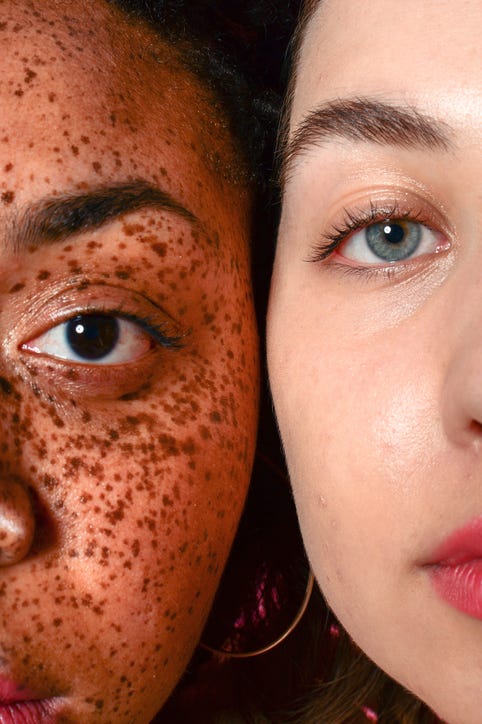The original post is located at www.elle.com
We all have skin (it’s the body’s biggest organ), but it’s also what makes us different. Skin comes in all different shades, textures, types, and undertones, and each has its own conditions and challenges. Dermatologists—as the doctors of skin—should know how to treat every variation. Yet, dermatology is one of the least inclusive professions, and the second least diverse specialty in medicine. Hispanics make up about 19 percent of the overall population in the United States, but only 4.2 percent of U.S. dermatologists are Hispanic.
The Latiné diversity gap in dermatology has been highlighted as an issue, because it directly affects patient health. This disparity has been pinpointed in clinical studies, and physician coalitions are advocating for change.
“I think people are desperate to find derms who really understand their skin concerns,” says Mara Velez, MD, a dermatologist in New York City. Velez notes that patients feel more understood when they have a doctor who can speak their native language. Having a dermatologist who truly understands Latiné skin—because they grew up in the culture and understand the customs—can lead to more accurate diagnoses, or reduce the risk of patients being misdiagnosed.
Velez notes that skin color can vary across the Latiné population—ranging from extremely fair to deep—and it’s important for dermatologists to have training across many different skin tones. “Even though [a Latiné patient] might look lighter, [that patient can] still [be] prone to the same things that darker counterparts might be prone to.” Some conditions are more common on Latiné skin, regardless of skin color. For example, a 2023 study showed that chronic conditions like atopic dermatitis (a disease that causes redness and inflammation) and alopecia (an autoimmune disease that causes hair loss) affect Hispanics and Latinos at much higher rates than other communities. Latiné patients are also more likely than white patients to develop pigmentary disorders like melasma, which causes dark patches on the skin.
Even though these skin conditions are pervasive, Latiné patients are often less likely to go to the dermatologist. A 2022 study from the Journal of Clinical and Aesthetic Dermatology
A more inclusive approach to dermatology doesn’t need to just come from diversity in doctors—clinical images and trials also need more Latiné representation. One 2020 study found that in general medical textbooks, only 4.5 percent of images showed darker skin tones. Since skin conditions present differently across skin tones, it can be a real problem if doctors are only familiar with white skin. Melanoma, the most dangerous form of skin cancer, can look less pronounced on darker skin tones, and it is often diagnosed at later stages when it presents on dark skin versus light skin. Once it’s more advanced, this cancer is harder to treat.
“The historic lack of representation of clinical images on dark skin types can be a contributing factor to the underdiagnosis of dermatologic disease in skin of color,” says Stephanie Florez-Pollack, MD, a dermatologist in Texas, co-founder of the Latinx Derm Directory, and member of the Skin of Color Society. “This is especially troubling for trainees who do not receive exposure to diverse patient populations and may enter the workforce without the proper tools to diagnose common diseases in different skin types.”
Florez-Pollack notes that transparency in race reporting has improved in clinical trials, but representation is still lacking, leading to fewer discoveries about how different skin conditions affect Latiné skin. For example, one study notes that Latiné patients get psoriasis less than their white counterparts, but the disease is more likely to be severe—and very little research exists as to why. Velez says that, at the end of the day, if dermatologists-in-training aren’t able to learn on a wide variety of skin tones, they will miss diagnoses.
Though there’s still a long road ahead, organizations like the Skin of Color Society and the American Academy of Dermatology (AAD) are attempting to help close the diversity gap. In collaboration with Johnson & Johnson and Kenvue, AAD’s Pathways program aims to increase the number of dermatologists from underrepresented communities. “The beauty of this program is it starts with programming from the high-school age, and goes all the way through medical school and residency,” says Seemal R. Desai, MD, FAAD, president of AAD. “It’s a long-term translational program that’s not only targeting [medical] residents.” The Pathways program aims to increase the number of Latiné, Black, and Indigenous dermatologists by 150 percent by 2027.
There have already been improvements in closing the gap. “Between 2016 and 2022, the number of dermatology residents who graduated from U.S. dermatology residencies who are Hispanic or Latino increased from 3.3 percent of graduating residents to almost 8 percent,” Desai says.
Big steps have also been taken to improve representation in clinical trials and images. The AAD has launched a skin of color curriculum developed by its members. This curriculum consists of five 15-minute modules that don’t just help derms make diagnoses—they also help educate physicians about the disparities in health care for both doctors and patients, plus teach them how to identify implicit biases and microaggressions.
The AAD is also currently in the process of putting together a photo library that shows how skin conditions present differently across skin tones. “We have images of the top 20 conditions in patients with darker skin tones,” Desai says. “These images are sourced from our members and will be available as a free member benefit for dermatologists to be able to feel more comfortable with different diseases on all different varieties of skin tones.”
Hopefully, with more resources and dedication, we can soon have more derms who are as diverse as the patients they serve. When it comes to the Latiné dermatology gap, it’s not about hitting DEI initiatives or checking off boxes—closing this gap means better outcomes and quality of care for patients of all skin tones and backgrounds. Without question, that’s something worth fighting for.










